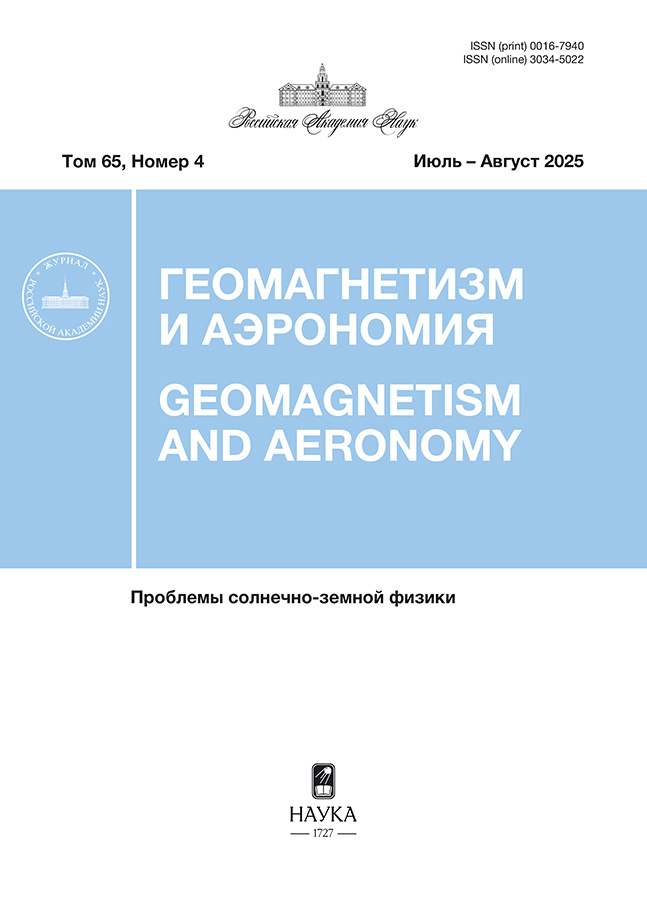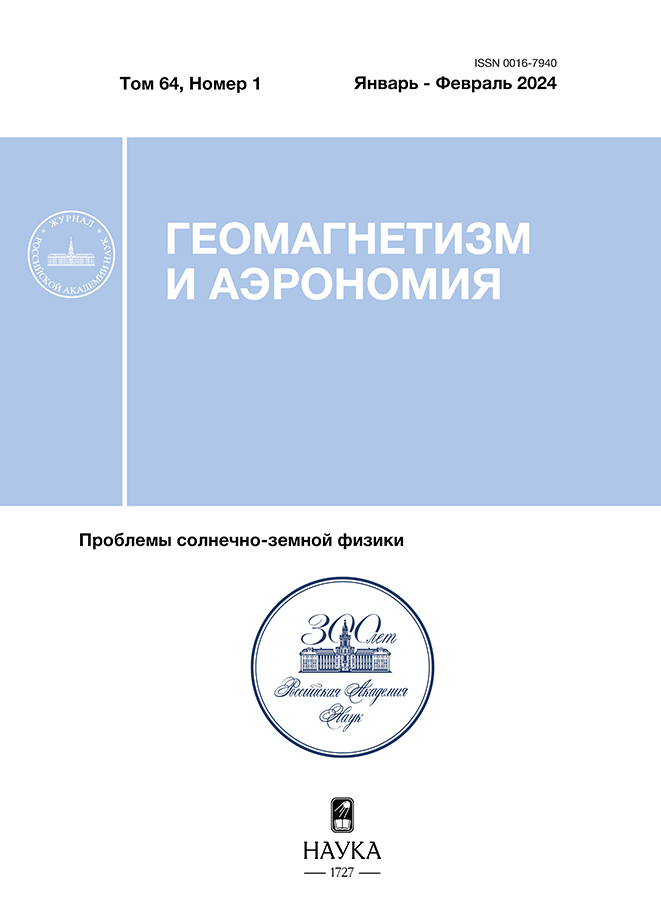Spectra and anisotropy of cosmic rays during gle64
- Authors: Kovalev I.I.1, Kravtsova M.V.1, Olemskoy S.V.1, Sdobnov V.E.1
-
Affiliations:
- Institute of Solar-Terrestrial Physics of Siberian Branch of Russian Academy of Sciences
- Issue: Vol 64, No 1 (2024)
- Pages: 55-59
- Section: Articles
- URL: https://ruspoj.com/0016-7940/article/view/650956
- DOI: https://doi.org/10.31857/S0016794024010066
- EDN: https://elibrary.ru/GQNWGL
- ID: 650956
Cite item
Abstract
Ground-based observations of cosmic rays by the spectrographic global survey method were used to study the ground-level enhancement in cosmic ray intensity on August 24, 2002. Spectra of variations of primary cosmic rays and their anisotropy were obtained. Based on measurements from the GOES spacecraft and global network of cosmic ray stations, the differential rigidity spectra of accelerated particles in the vicinity of the Sun were calculated. The maximum rigidity to which solar particles were accelerated was estimated.
Full Text
About the authors
I. I. Kovalev
Institute of Solar-Terrestrial Physics of Siberian Branch of Russian Academy of Sciences
Author for correspondence.
Email: ivankov@iszf.irk.ru
Russian Federation, Irkutsk
M. V. Kravtsova
Institute of Solar-Terrestrial Physics of Siberian Branch of Russian Academy of Sciences
Email: rina@iszf.irk.ru
Russian Federation, Irkutsk
S. V. Olemskoy
Institute of Solar-Terrestrial Physics of Siberian Branch of Russian Academy of Sciences
Email: osv@iszf.irk.ru
Russian Federation, Irkutsk
V. E. Sdobnov
Institute of Solar-Terrestrial Physics of Siberian Branch of Russian Academy of Sciences
Email: sdobnov@iszf.irk.ru
Russian Federation, Irkutsk
References
- Белов А.В., Ерошенко Е.А., Крякунова О.Н., Курт В.Г., Янке В.Г. Наземные возрастания солнечных космических лучей в трех последних циклах солнечной активности // Геомагнетизм и аэрономия. Т. 50. №1. С. 23—36. 2010.
- Дворников В.М., Кравцова М.В., Сдобнов В.Е. Диагностика электромагнитных характеристик межпланетной среды по эффектам в космических лучах // Геомагнетизм и аэрономия. Т. 53. № 4. С. 457—468. 2013. https://doi.org/10.7868/S001679401304007X
- Логачёв Ю.И., Базилевская Г.А., Вашенюк Э.В. и др. Каталог солнечных протонных событий 23-го цикла солнечной активности (1996−2008 гг.). ESDBrepository, ГЦ РАН, Москва. https://doi.org/10.2205/ESDB-SAD-P-001-RU
- Луковникова А.А., Сдобнов В.Е. Питч-угловая анизотропия и дифференциальные жесткостные спектры космических лучей во время GLE 2 и 6 мая 1998 г. // Солнечно-земная физика. Т. 8. № 2. С. 29—33. 2022. https://doi.org/10.12737/szf-82202204
- Dvornikov V.M., Sdobnov V.E. Analyzing the solar proton event of 22 October 1989, using the method of spectrographic global survey // Solar Phys. V. 178. № 2. P. 405—422. 1998.
- Gopalswamy N., Xie H., Yashiro S., et al. Properties of ground level enhancement events and the associated solar eruptions during solar cycle 23 // Space Sci. Rev. V. 171. P. 23—60. 2012. https://doi.org/10.1007/s11214-012-9890-4
- Kovalev I.I., Olemskoy S.V., Sdobnov V.E. A proposal to extend the spectrographic global survey method // J. Atmosp. Solar-Terr. Phys. V. 235. P. 105887. 2022. https://doi.org/10.1016/j.jastp.2022.105887
- Kravtsova M.V., Sdobnov V.E. Cosmic ray ground level enhancement on August 24, 1998 // Bull. Rus. Acad. Sci.: Phys. V. 87. № 7. P. 1018—1020. 2023. https://doi.org/10.3103/S1062873823702428
- Lugaz N., Roussev I.I., Sokolov I.V., Jacobs C. The August 24, 2002 coronal mass ejection: when a western limb event connects to earth // Proc. IAU 257 Symposium. P. 391—398. 2009. https://doi.org/10.1017/S1743921309029615
- Miroshnichenko L.I. Solar Cosmic rays: fundamentals and applications. Springer, 2014. 521 p.
- Miroshnichenko L.I., Yanke V.G. Size distributions of solar proton events: methodological and physical restrictions // Solar Phys. V. 291. P. 3685—3704. 2016. https://doi.org/10.1007/s11207-016-1002-2
- Mishev A., Poluianov S., Usoskin I. Assessment of spectral and angular characteristics of sub-GLE events using the global neutron monitor network // J. Space Weather and Space Climate. 7. A28. 2017. https://doi.org/10.1051/swsc/2017026
- Papaioannou A., Kouloumvakos A., Mishev A., et al. The first ground level enhancement of solar cycle 25 on 28 October 2021 // Astron. Astrophys. V. 660. L5. 2022. https://doi.org/10.1051/0004-6361/202142855
- Raymond J. C., Ciaravella A., Dobrzycka D., et al. Far-ultraviolet spectra of fast coronal mass ejections associated with X-class flares // Astrophys. J. V. 597. № 2. P. 1106—1117. 2003. https://doi.org/10.1086/378663
- Struminsky A.B., Logachevb Yu.I., Grigorieva I.Yu., Sadovski A.M. Two types of gradual events: solar protons and relativistic electrons // Geomag. Aeron. V. 60. № 8. P. 1057—1066. 2020. https://doi.org/10.1134/S001679322008023X
- URL CME, hhttps://cdaw.gsfc.nasa.gov/CME_list
- URL Data GLE, hhttps://gle.oulu.fi
- URL IZMIRAN, hhttps://cr0.izmiran.ru
- URL Flares, hhttps://www.solarmonitor.org/
- URL GOES, hhttps://www.goes.noaa.gov/
- URL NMDB, hhttps://www.nmdb.eu/
- URL SEP, hhttps://umbra.nascom.nasa.gov/SEP/
Supplementary files















